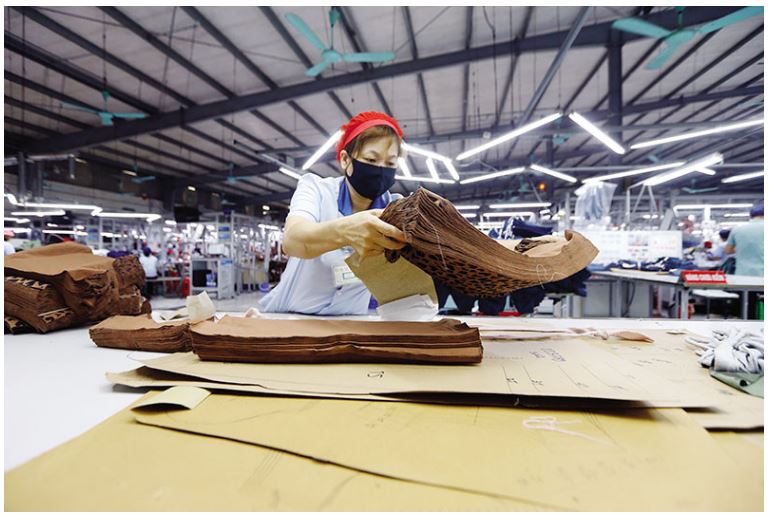Vietnam: Textile and garment industry still has great demand for foreign capital
The textile and garment industry still has a great need to attract foreign capital for the production of fabrics, yarns and accessories to serve export needs to take advantage of tariff preferences from free trade agreements (FTAs).
Data from the Foreign Investment Department (Ministry of Planning and Investment) shows that, as of May 18, 2022, in the textile and garment sector, there were 2,787 valid foreign direct investment (FDI) projects with registered capital of 31.3 billion USD.
The arrival of FDI projects has caused production capacity and export scale of the textile and garment industry to increase rapidly. In 2018, total export turnover of the industry reached over 36 billion USD and in 2021 it was 40.3 billion USD, of which the FDI sector held about 60% of total export value.
The industry scale is large, and an important link in the global supply chain, but it is necessary to direct capital flows into the right “bottleneck” areas of the industry: fabric, yarn, and auxiliary production to take advantage of tariff preferences from 15 FTAs are in effect.
According to Mr. Nguyen Anh Tuan, Deputy Director of the Foreign Investment Department, the textile and garment industry is lacking in linkages along the value chain. Vietnam has a trade surplus for yarn and garments, but a large deficit for fabrics. Yarn produced is mainly for export, while domestically produced fabrics only meet nearly 50% of the demand, causing Vietnam to import more than 10 billion USD of fabrics each year.
“This shortfall is a potential market segment to attract foreign investment in fabric and yarn production in Vietnam,” said Mr. Tuan.
Data from the General Department of Customs shows that in 2021 the import of raw fabrics will reach USD 14.3 billion, up 20.6% compared to 2020, accounting for 60.0% of the total import value of raw materials and accessories of the industry. Imports from the markets of China, Korea, Taiwan and Thailand increased sharply.
Completing the domestic value chain
In fact, new generation FTAs such as CPTPP or EVFTA all set requirements on rules of origin, and yarns and fabrics must be produced and used in Vietnam or in FTA countries to be certified for export rules and enjoy preferential tariffs.
Therefore, textile enterprises are forced to focus on developing along the entire chain, forming a domestic value chain.
Looking at the level of foreign currency spending to import raw materials and accessories, although export turnover is over 40 billion USD, raw materials a lot of cotton, fiber, and fabric are imported. In 2021 it amounted to 23.86 billion USD, up 21.3% compared to 2020.
The industry’s four major market areas are the US, EU, South Korea and China, which import nearly $24 billion of textiles and fibers from Vietnam each year (in 2021). These markets are enforcing many new regulations related to imported garments such as requiring products to be green, chemical-free, and recyclable.
Without direct investment, it will be difficult for textile and garment exports to keep the top three position.
“The textile and garment industry needs to selectively attract foreign investment, and prioritize investment projects in advanced textile dyeing technology. It should not cause adverse impacts on the environment, and should connect with domestic garment enterprises, shape into a link chain throughout the value chain, and use solutions in science and technology to green the textile and garment industry,” said Mr. Nguyen Anh Tuan.
Emphasizing the increasing requirements of importers, Mr. Truong Van Cam, Vice President of the Vietnam Textile and Apparel Association (Vitas), noted that the production technology of the yarn, weaving and dyeing industry must meet green standards. It must reduce fuel consumption and water consumption, and ensure transparent connections throughout the supply chain.
Currently, most Vietnamese enterprises in the supply chain of the textile and garment industry that process for big brands have received requirements for “greening” in production, such as social and environmental responsibilities and cutting emissions and waste. New generation FTAs that Vietnam participates in all have commitments on environmental protection and low emissions.
At the recent Prime Minister’s Meeting with businesses, on behalf of Vitas, Mr. Cam suggested that the Government approve the Strategy for Textile Industry Development soon and establish a large textile industrial park to solve the problem of fabrics, dyeing, and chemicals to attract businesses to invest in fabric production.
Dau Tu
Source: https://vietnamnet.vn/en/textile-and-garment-industry-still-has-great-demand-for-foreign-capital-2057006.html


 Thailand
Thailand




